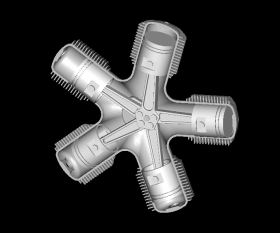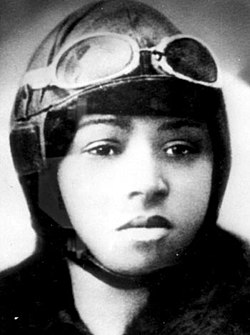Portal:Aviation
| Main page | Categories & Main topics |
|
Tasks and Projects |
The Aviation Portal

Aviation includes the activities surrounding mechanical flight and the aircraft industry. Aircraft includes fixed-wing and rotary-wing types, morphable wings, wing-less lifting bodies, as well as lighter-than-air aircraft such as hot air balloons and airships.
Aviation began in the 18th century with the development of the hot air balloon, an apparatus capable of atmospheric displacement through buoyancy. Clément Ader built the "Ader Éole" in France and made an uncontrolled, powered hop in 1890. This is the first powered aircraft, although it did not achieve controlled flight. Some of the most significant advancements in aviation technology came with the controlled gliding flying of Otto Lilienthal in 1896; then a large step in significance came with the construction of the first powered airplane by the Wright brothers in the early 1900s. Since that time, aviation has been technologically revolutionized by the introduction of the jet which permitted a major form of transport throughout the world. (Full article...)
Selected article
Selected image

Did you know
...that a Fairchild C-119 Flying Boxcar was used in the 2004 film Flight of the Phoenix? ..that Elm Farm Ollie in 1930 became the first cow to be milked while flying in an airplane? ...that François Denhaut built the world's first flying boat, or seaplane with a hull?
General images -
In the news
- May 29: Austrian Airlines cancels Moscow-bound flight after Russia refuses a reroute outside Belarusian airspace
- August 8: Passenger flight crashes upon landing at Calicut airport in India
- June 4: Power firm helicopter strikes cables, crashes near Fairfield, California
- January 29: Former basketball player Kobe Bryant dies in helicopter crash, aged 41
- January 13: Iran admits downing Ukrainian jet, cites 'human error'
- January 10: Fire erupts in parking structure at Sola Airport, Norway
- October 27: US announces restrictions on flying to Cuba
- October 3: World War II era plane crashes in Connecticut, US, killing at least seven
- September 10: Nevada prop plane crash near Las Vegas leaves two dead, three injured
- August 6: French inventor Franky Zapata successfully crosses English Channel on jet-powered hoverboard
Related portals
Associated Wikimedia
The following Wikimedia Foundation sister projects provide more on this subject:
-
Commons
Free media repository -
Wikibooks
Free textbooks and manuals -
Wikidata
Free knowledge base -
Wikinews
Free-content news -
Wikiquote
Collection of quotations -
Wikisource
Free-content library -
Wikiversity
Free learning tools -
Wikivoyage
Free travel guide -
Wiktionary
Dictionary and thesaurus
Selected biography
Selected Aircraft

The Avro Lancaster was a British four-engine Second World War bomber aircraft made initially by Avro for the British Royal Air Force (RAF). It first saw active service in 1942, and together with the Handley-Page Halifax it was one of the main heavy bombers of the RAF, the RCAF and squadrons from other Commonwealth and European countries serving within RAF Bomber Command. The "Lanc" or "Lankie," as it became affectionately known, became the most famous and most successful of the Second World War night bombers, "delivering 608,612 tons of bombs in 156,000 sorties." Although the Lancaster was primarily a night bomber, it excelled in many other roles including daylight precision bombing, and gained worldwide renown as the "Dam Buster" used in the 1943 Operation Chastise raids on Germany's Ruhr Valley dams.
- Span: 102 ft (31.09 m)
- Length: 69 ft 5 in (21.18 m)
- Height: 19 ft 7 in (5.97 m)
- Engines: 4× Rolls-Royce Merlin XX V12 engines, 1,280 hp (954 kW) each
- Maximum Speed: 240 knots (280 mph, 450 km/h) at 15,000 ft (5,600 m)
- First Flight: 8 January 1941
- Number built: 7,377
Today in Aviation
- 2013 – Boeing makes the second of two Boeing 787 Dreamliner test flights to show that modifications to the 787's lithium-ion battery system have solved the problem of battery overheating experienced by Dreamliners earlier in the year. The aircraft, bearing the livery of LOT Polish Airlines, makes a 755-mile (1,216-kilometer) flight along the United States West Coast in just under two hours without incident. The completion of two successful test flights is a major step toward ending the worldwide grounding of 787s.[1]
- 2011 – Coalition airtsrikes against an eight-vehicle Libyan government military convoy approaching rebel positions 30 km (18.6 miles) east of Brega destroy two vehicles. The rest turn back.[2]
- 2010 – Launch: Space Shuttle Discovery STS-131 at 10:21:22 UTC. Mission highlights: ISS assembly flight 19A: Utility and Logistics Flight 4: Multi-Purpose Logistics Module Leonardo. Last night launch of the Shuttle Program.
- 2008 – Skybus Airlines ceased operations due to poor economy and rising fuel prices.
- 2007 – A UH-60 Black Hawk carrying nine is shot down in Latifiya about 20 miles south of Baghdad around 0730hrs local time. using anti-aircraft heavy machine guns, 4 were wounded.[3][4][5]
- 1996 – First flight of the Lockheed Martin C-130J Super Hercules.
- 1994 – A U.S. Navy Grumman A-6 Intruder, based at NAS Alameda, crashes into the San Francisco Bay, California at 1200 hrs., close to the mid-span of the San Francisco-Oakland bridge, killing two crew, the Coast Guard said.
- 1991 – Atlantic Southeast Airlines Flight 2311, an Embraer 120RT Brasília, rolls sharply and crashes on final approach to Brunswick, Georgia, killing all 23 people on board, including former Texas senator John Tower, his adult daughter, and astronaut Sonny Carter.
- 1991 – Launch: Space Shuttle Columbia STS-37 at 09:22:44 EST. Mission highlights: Compton Gamma Ray Observatory deployment.
- 1982 – Royal Navy aircraft carriers HMS Hermes and HMS Invincible depart the United Kingdom for the Falkland Islands.
- 1976 – Howard Hughes dies aboard a Learjet, aged 70 (b. 1905).
- 1968 – To protest the lack of an aerial display to commemorate the 50th anniversary of the founding of the Royal Air Force four days earlier and to demonstrate against the government of Prime Minister Harold Wilson, Flight Lieutenant Alan Pollock of the RAF's No. 1(F) Squadron makes an unauthorized display flight in a Hawker Hunter during which he "beats up" (i. e., buzzes) several RAF airfields and flies low over London, where circles the Houses of Parliament, dips his wings to the Royal Air Force Memorial, and flies under the top span of Tower Bridge, becoming the first person to fly under the bridge's upper span in a jet aircraft. He is arrested upon his return to base.
- 1966 – A Hurlburt Field, Florida-based North American T-28 Trojan makes a forced landing on the Eglin AFB, Florida, reservation, but suffers little damage and the two crew are unhurt.
- 1965 – A U. S. Navy RF-8 Crusader reconnaissance aircraft photographs an SA-2 Guideline surface-to-air missile (SAM) site under construction in North Vietnam for the first time, but President Lyndon B. Johnson's administration does not authorize strikes against North Vietnamese SAM sites until late July. To meet the threat the SA-2 s pose, during April the U. S. Air Force adds radar homing and warning equipment to its Lockheed U-2 reconnaissance aircraft and deploys EB-66 B Destroyer electronic countermeasures aircraft to Southeast Asia.
- 1964 – 1964 Machida F8 crash: A United States Marine Corps F8U-2 Crusader returning from Kadena Air Base, Okinawa to its home base of Naval Air Facility Atsugi, Kanagawa Prefecture suffered a mechanical malfunction and crashed into a residential neighborhood in Machida, Tokyo, Japan. The crash killed four people and injured 32 others on the ground. The aircraft's pilot successfully ejected and was not seriously injured.
- 1959 – The Aero L-29 Delfín, the first jet aircraft designed and built in Czechoslovakia, made its first flight. Over 3,000 of these jet trainers are produced for the Soviet Union and other Warsaw Pact air forces.
- 1956 – A Boeing B-47 Stratojet of the 307th Bomb Wing departs Lincoln AFB, Nebraska, at ~1125 hrs. on a northern heading. Approximately 15 minutes later, it exploded and burst into flames at ~2,000 feet (610 m) altitude, crashing three miles (5 km) S and ¾ miles E of Ceresco, Nebraska. The crew of four, one over the normal crew complement, is killed.
- 1951 – First of two pilotless Royal Australian Air Force GAF Pikas, (Project 'C'), A92-1, C-1, "P", crashes at Woomera, Australia, and is subsequently broken up. Second prototype is now on display at the RAAF Museum at Point Cook. Production drones will be built as GAF Jindiviks.
- 1950 – AMartin JRM-3 Mars flying boat, BuNo 76822, c/n 9266, "Marshall Mars", destroyed by fire near Honolulu, Hawaiian Islands – force landed in Keehi Lagoon, Oahu with engine fire. Crew were rescued after which aircraft exploded.
- 1949 – Judith Resnik, American astronaut, was born (d. 1986). Judith Arlene Resnik was an American engineer and a NASA astronaut who died in the destruction of the Space Shuttle Challenger during the launch of mission STS-51-L.
- 1948 – 1948 Gatow air disaster: A Soviet Yakovlev Yak-3 fighter buzzes a British European Airways Vickers VC.1B Viking, G-AIVP, c/n 229, while it is on a scheduled flight to Berlin, Germany, then collides with the wing of the airliner, killing the pilots of both aircraft and ten passengers on the Viking. Total fatalities is 15.
- 1947 – First complete flight from take-off to safe landing of the Hughes XF-11 piloted by Howard Hughes.
- 1946 – Brewster Aeronautical Corporation is dissolved by its shareholders.
- 1945 – Prototype Ryan XFR-1 Fireball, BuNo 48234, piloted by Ryan test pilot Dean Lake, on test flight over Lindbergh Field, San Diego, California, loses skin between the front and rear spars of the starboard wing, interrupted airflow over the wing causes it to disintegrate. Pilot bails out, airframe breaks up, wreckage strikes brand new Consolidated PB4Y-2 Privateer, BuNo 59836, just accepted by the Navy and preparing to depart for the modification center at Litchfield Park, Arizona. Bomber burns, Navy crew of pilot Lt. D. W. Rietz, Lt. J. E. Creed, and Aviation Machinists Mates G. R. Brown and J. H. Randall, evacuate burning PB4Y, only Randall suffering injuries, first, second, and third-degree burns and minor lacerations.
- 1944 – First flight of the Miles Monitor
- 1944 – Fifth Air Force aircraft again attack Japanese airfields around Hollandia.
- 1942 – 105 aircraft from the Japanese aircraft carriers Akagi, Hiryū, Sōryū, Shōkaku, and Zuikaku strike Colombo, Ceylon. A second wave sinks the British heavy cruisers HMS Cornwall and HMS Dorsetshire southwest of Ceylon.
- 1940 – First flight of the Mikoyan-Gurevich MiG-1, Soviet fighter aircraft.
- 1937 – The Douglas Aircraft Company takes over Northrop.
- 1910 – The first built Canadian built monoplane and the first airplane for export, Canadian Aerodrome Hubbard Monoplane, was flown at Baddeck. Nova Scotia.
- 1907 – First flight of the Blériot V monoplane by Louis Blériot.
References
- ^ Reuters, "Boeing's Dreamliner Passes Test Flight," The Washington Post, April 6, 2013, p. A8.
- ^ Lamloum, Imed (5 April 2011). "Libya Open to Reform, Rebels Pushed Back". Agence France-Presse (via Zawya.com). Retrieved 9 April 2011.
- ^ "Al-Qaida claims it downed US helicopter in Iraq". The Jerusalem Post. 2007-04-08. Retrieved 2007-05-30.
- ^ "U.S. Helicopter Incidents in Iraq". London: Guardian Unlimited. 2007-04-05. Archived from the original on May 2, 2007. Retrieved 2007-05-30.
- ^ Margaret Besheer (2007-04-05). "4 Injured After US Helicopter Crashes South of Baghdad". Voice of America. Retrieved 2008-06-07.
- ^ "rothers Killed in Action in USMC Helicopters or while assigned to USMC Helicopter Squadrons in Operation IRAQI FREEDOM". Retrieved 2010-02-16.
- Shortcuts to this page: Portal:Airplanes • P:AVIA





















































